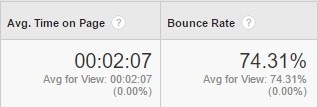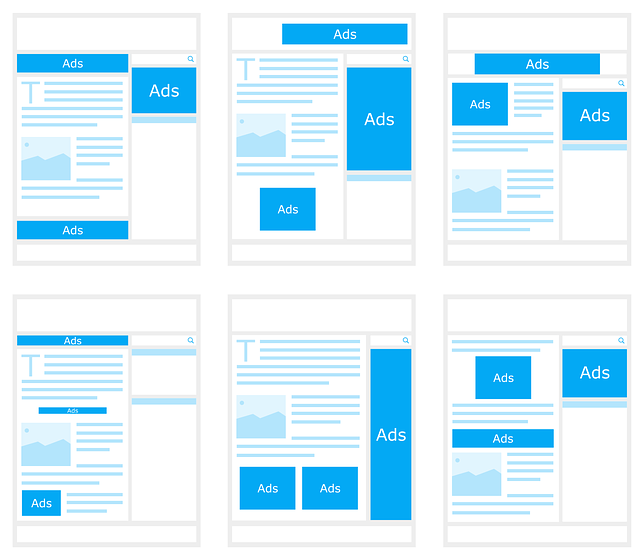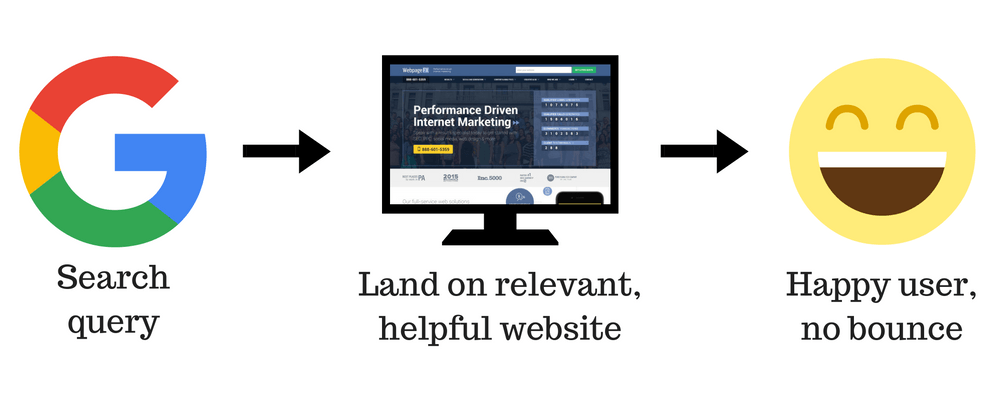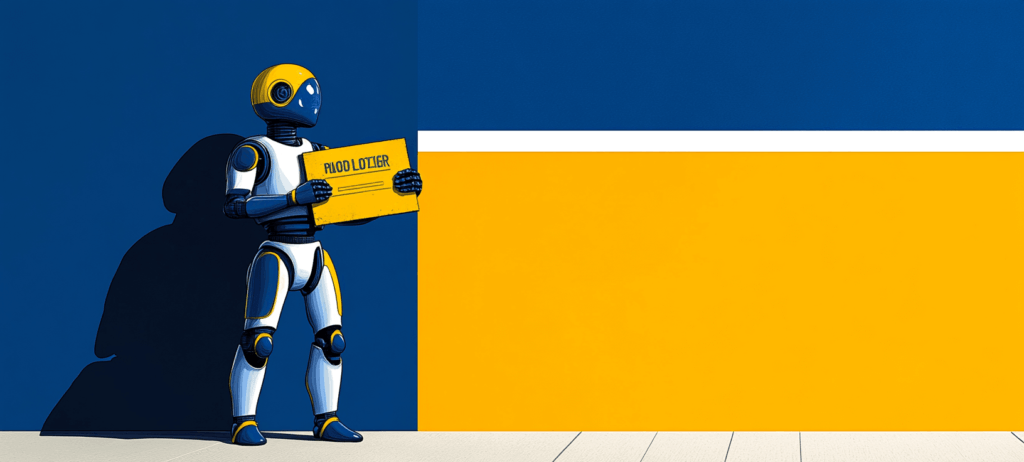-
 8 min. read
8 min. read
-
Summarize in ChatGPT
-
 Ryan Maake
Ryan Maake Lead Marketing Consultant
Lead Marketing Consultant
- Ryan is a Lead Marketing Consultant at WebFX. Follow him on Twitter @rmaake107! @rmaake107
If you want to increase time on page and reduce bounce rate, you’re in the right place! Two of the best metrics for determining how effective your site is at providing the information your visitors want are time on page and bounce rate. It stands to reason that longer user sessions and fewer bounces mean you’re doing something right with your content.
Unfortunately, it can be very difficult to diagnose the cause of short user sessions and high bounce rates. Let’s dig into exactly what time on page and bounce rate represent, along with some tricks to reduce bounce rate and increase time on page for your website.
What are the time on page and bounce rate metrics?
Both are fairly self-explanatory measurements: Time on page describes how long a user spends on a given web page, and bounce rate refers to the percentage of users that “bounce” off of your website and return to the site they came from. However, it’s very important to understand that both metrics have a few caveats.

Calculating time on page and bounce rate
Google calculates the time on page metric only within the context of a single website. In other words, they use two clicks to calculate time on page: the “entry” click of a user navigating to a page on your website, and the “exit” click of a user navigating to another page on your website. They can then use the corresponding timestamps to calculate time on page for the first page.
- Without that second click, Google can’t give you an accurate time on page measurement, and it’ll appear as 0 minutes in Google Analytics.
- This means that the last page of a user’s session on your site will always have a time on page of 0 minutes because there won’t be an “exit” click to a different page.
This comes with some obvious problems, namely: What about users who only visit one page on your website? This is important because one-page visits can occur quite often – typically due to informational search queries.
Example of a one-page visit affecting time on page and bounce rate
For example, let’s say you run a website about the Empire State Building. A common search might be “how many staircases are in the empire state building?” If a user navigates to your website from the SERPs and lands on a page that has plenty of information about how many staircases the ESB has, how it stacks up against other tall buildings, and so on, it’s safe to say their search query has been answered by your high quality, relevant content.
But because they only wanted that one piece of information, they’ll probably hit the “back” button or otherwise navigate away from your site as soon as they have their answer. Since they were only on a single page of your website, their time on page for your article will be reported as 0 minutes, and the bounce rate will increase. You can see why this is problematic.
Fantastic content ends up with a low time on page and high bounce rate, even though it’s exactly what Google wants to see in the SERPs. Google itself does seem to track “dwell time,” which is the true amount of time visitors spend on your page. However, there’s no “dwell time” column that you can view in Google Analytics.
Thankfully, there are some workarounds that let you approximate these metrics for one-page visits. But unless you’re using one of them, always remember that there are some situations in which the reported “time on page” and “bounce rate” metrics will be wildly inaccurate or entirely useless.
How to increase time on page and reduce bounce rate
Now that we’ve gone over the limitations of time on page and bounce rate, we can talk about improving both metrics. These tips focus on how to increase time on page, but if you execute them well, your bounce rate will naturally go down because people will be interacting with your page for a longer period of time.
-
Publish high-quality content to make people want to keep reading
Right off the bat, the most obvious way to increase time on page is by publishing high-quality content. Content creation is an entirely separate subject, so suffice to say “high quality” content in this context means content that provides what your visitors are looking for. It should be relevant to their searches, and it should solve a user issue or streamline a pain point for your business.
If your content is high quality but you’re still seeing shorter user sessions, there are a few things you can do to bump up that time on page number:
-
Restructure your content to improve user experience
Even if your content answers a search query, users might be having a hard time finding the answer after landing on your page.  Putting in a table of contents on longer articles and making sure your content is formatted with user experience and readability in mind are two great ways of helping users and keeping them on your website instead of overwhelming them with poorly formatted, buried information.
Putting in a table of contents on longer articles and making sure your content is formatted with user experience and readability in mind are two great ways of helping users and keeping them on your website instead of overwhelming them with poorly formatted, buried information.
-
Add to your content to increase time on page
This one’s the simplest option, but it’s often overlooked. If you have a great piece of content, look for ways to make it better! Maybe you gloss over a topic that your readers want more detail on, or maybe there’s a hole in your content that you overlooked.
Perform a content audit and identify any areas where you might be able to improve upon what you’ve already published.
-
Add interactivity to encourage interaction and boost time on page
This is another simple way to increase time on page. People like interacting with things, so give them things to interact with! If you published an article about taking out loans, for example, you could build a simple interest rate calculator into the page.
Users love this kind of interactivity, and it can usually be implemented with some simple HTML and JavaScript. It doesn’t have to be anything too complex! If you don’t want to build something, you could also consider adding video instead.
If you have an instructional article that explains how to do something, for example, you could embed a relevant YouTube video on the page. There is an endless number of ways to enhance your existing content with interactive media that will increase the time users spend on that page. 
What causes a high bounce rate?
A “true” bounce happens when a user navigates to your page but exits your site within a short period of time (usually back to the SERPs) instead of visiting another one of your pages.
Most true bounces happen due to irrelevant or horribly-presented content, bad design, or something else that isn’t in line with the user’s expectations. The first step to reducing bounce rate is putting yourself in the position of a user and thinking about what their expectations might be, then comparing them to the reality of your page. For example, pretend your users are expecting informational content based on the title of a page.
If your site instead blindsides them with an overt sales pitch, they’re going to hit that “back” button very quickly. Maybe your headlines are badly written and create discord between your content and the user’s search intent, even if the content of your page is legitimately helpful. You’ll see a higher bounce rate.
In this case, the user will probably bounce even if it’s a well-written, informative page. Users make snap judgments within seconds, so it’s extremely important to show them that they’re in the right place from the moment they land on your website. The key to reducing bounce rate is the elimination, or reduction, of friction in the user’s experience.
An ideal user path looks something like this:  Anything else will result in a “true” bounce the majority of the time.
Anything else will result in a “true” bounce the majority of the time.
A quick note on the two metrics
It’s important to note, again, that time on page and bounce rate are frequently tied together. Improving your time on page will often reduce bounce rate, and most tricks to reduce bounce rate will often boost the length of user sessions. While there are always unique circumstances, keep in mind that most of the time you can’t really “target” one of them without affecting the other.
Start improving your time on page and reducing your bounce rate.
Give us a call at 888-601-5359 or reach out to us online to get started with your web strategy.
We hope to hear from you!
-
 Ryan is a Lead Marketing Consultant at WebFX. Follow him on Twitter @rmaake107!@rmaake107
Ryan is a Lead Marketing Consultant at WebFX. Follow him on Twitter @rmaake107!@rmaake107 -

WebFX is a full-service marketing agency with 1,100+ client reviews and a 4.9-star rating on Clutch! Find out how our expert team and revenue-accelerating tech can drive results for you! Learn more
Try our free Marketing Calculator
Craft a tailored online marketing strategy! Utilize our free Internet marketing calculator for a custom plan based on your location, reach, timeframe, and budget.
Plan Your Marketing Budget

Proven Marketing Strategies

Proven Marketing Strategies
Try our free Marketing Calculator
Craft a tailored online marketing strategy! Utilize our free Internet marketing calculator for a custom plan based on your location, reach, timeframe, and budget.
Plan Your Marketing Budget




